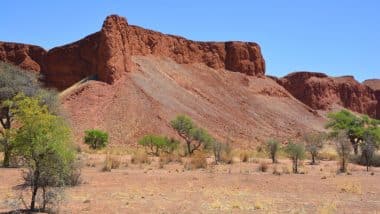The West African country of Namibia is predominantly characterized by countless natural attractions. If you are looking for African flair, you will definitely find it in the Namib-Naukluft National Park. The largest nature reserve in the African country and the largest wildlife park on the entire continent is located in the west of the country directly on the Atlantic coast and covers a total of almost 50,000 square kilometres.
Together with the Skeleton Coast, the Dorob National Park, the Meob-Chamais Marine Protected Area and the Fish River Canon, the Namib-Naukluft National Park has been forming the huge Namib Skeleton Coast National Park, the eighth largest protected area in the world, for several years. The Namib-Naukluft National Park offers a breathtaking African wilderness in all possible facets. In order to be able to explore the numerous small and large attractions of the national park extensively, you should definitely plan enough time. A safari lasting several days or a round trip is particularly suitable for this. In the national park, numerous lodges with different facilities offer welcome overnight accommodation.
With many tour operators, you can even book the different tours in advance. But there is also the possibility to opt for one of the tours with different levels of difficulty on site. To capture the many breathtaking impressions of the national park, you should always have a camera with you.
Largest dunes in the world, Spectacular climbing tours in the Naukluft Mountains
Most of the national park is dominated by the Namib Desert. However, large parts of the extensive grounds are not accessible to humans. After all, the huge desert extends far beyond Namibia’s borders to the neighbouring countries of Angola and South Africa. Only the area north of the Kuiseb River, the Sossusvlei and the Naukluft Mountains can be explored by humans. Nevertheless, the national park also has a lot of variety in store for tourists from all over the world. The 500-kilometre-long and almost 200-kilometre-wide Namib Desert in the west of the national park is the oldest desert in the world.
Among other things, you will also find the highest dunes in the world here. The Sossuvlei, a salt-clay pan framed by several 300-metre-high dunes, is not only one of the most spectacular attractions in the entire national park, but has also been a UNESCO World Heritage Site for several years. Climbers and hikers from all over the world, on the other hand, get their money’s worth in the almost 2,000-metre-high Naukluft Mountains in the east of the Namib-Naukluft National Park. To explore the mountains, visitors have several hiking and climbing tours at their disposal, some of which are also led by experienced tour guides and guides.
Stunning flora and fauna in the Namib-Naukluft National Park

Of course, you will also find what you are looking for in the huge national park in search of native animals and plants. A popular attraction for tourists from all over the world is Sandwich Harbour in the north of the park. More than 200,000 birds – from pelicans to cormorants to a wide variety of small and large seabirds – have found a home in the approximately 10-kilometre-long lagoon. The picturesquely situated lagoon can only be reached by off-road vehicle with all-wheel drive. Characteristic of the specific vegetation of the national park is above all the plant Welwitschia; which can live up to 2,000 years.
The plant, which is particularly widespread in the gravel desert north of the Kuiseb River, is so characteristic of Namibia that it can even be found in the country’s coat of arms. Occasionally, large acacias, camel thorn trees or dune grass grow in the Namib-Naukluft National Park. With a bit of luck, you can also observe zebras, baboons, jackals, roads or springboks in their natural habitat while exploring the park – including in the fertile river valleys. In the Meob-Chamais, a large and popular marine and island reserve, you can even see large African penguins in their natural habitat. The Namib-Naukluft National Park can be reached in the south via the B4 national road in the direction of the 12,000-inhabitant town of Lüderitz.
Best time to travel from April to June
The climate in the Namib-Naukluft National Park is characterized by hot temperatures of almost 50 degrees Celsius, especially in the summer months – especially in the extensive desert regions. There is only some rain here in the months of January and February. Due to the severe drought and high temperatures, it is essential to take plenty of water with you when exploring the national park. In contrast, it rains much more often in the Naukluft mountains. That’s why the vegetation here is much more varied than in the desert regions. The best time to visit the park is spring. Between April and June, pleasant temperatures of about 25 degrees Celsius prevail here. Even in the winter months, the temperature is still around 20 degrees Celsius during the day. However, night frost is always to be expected at night.


